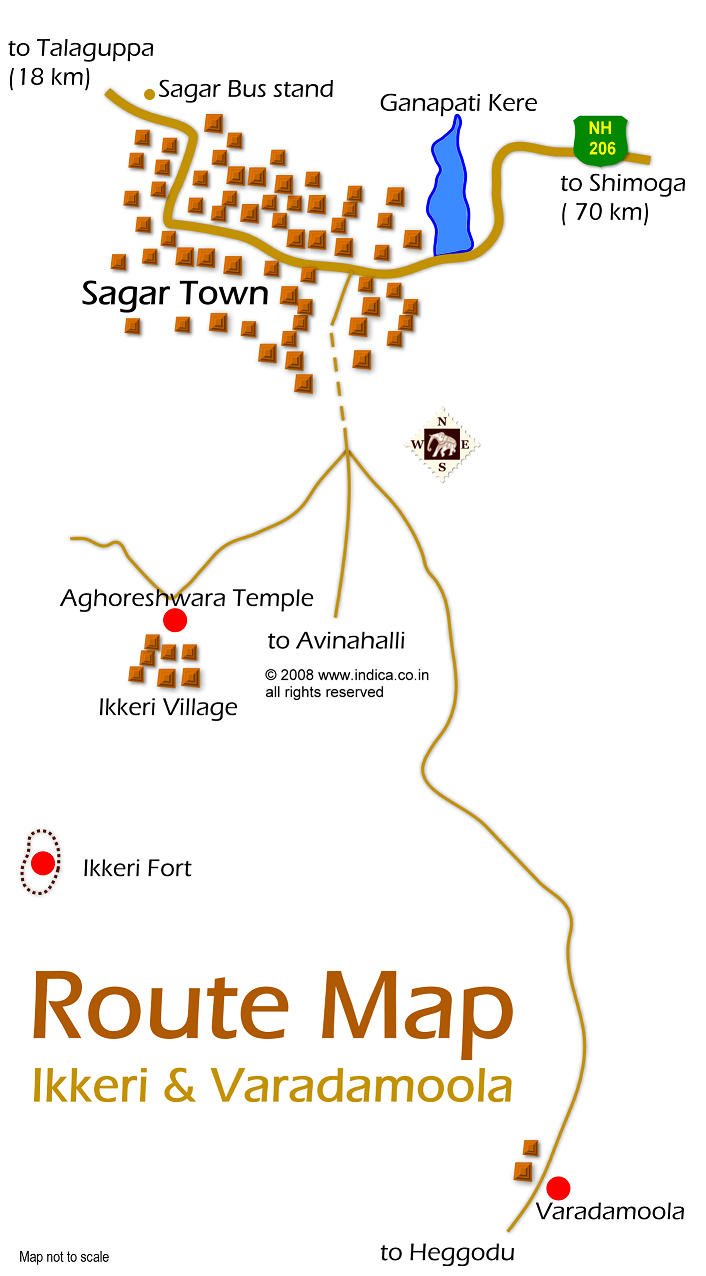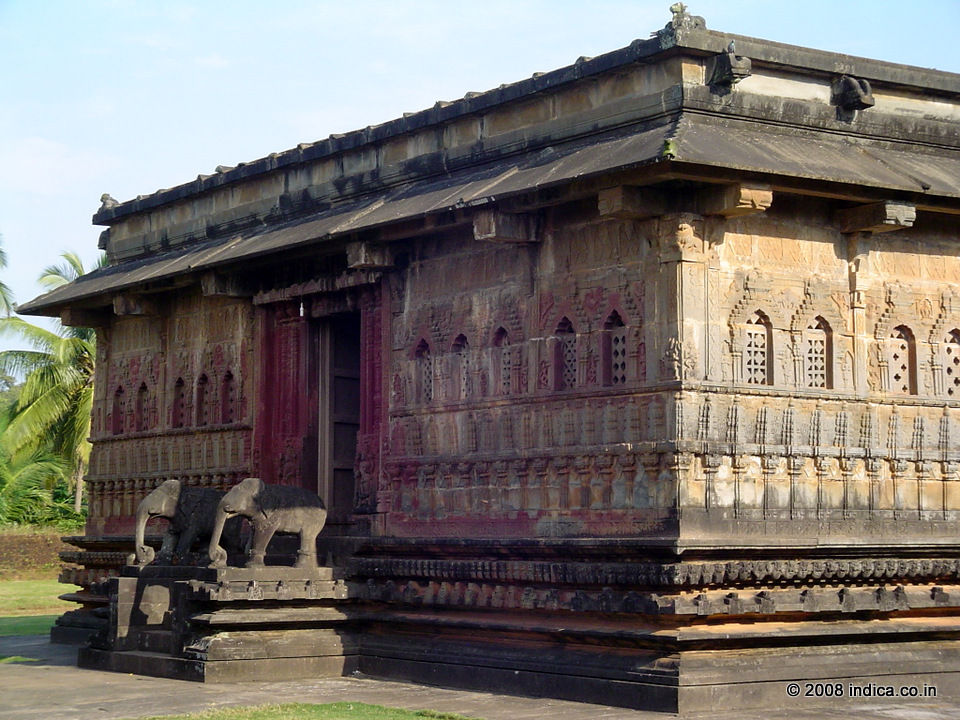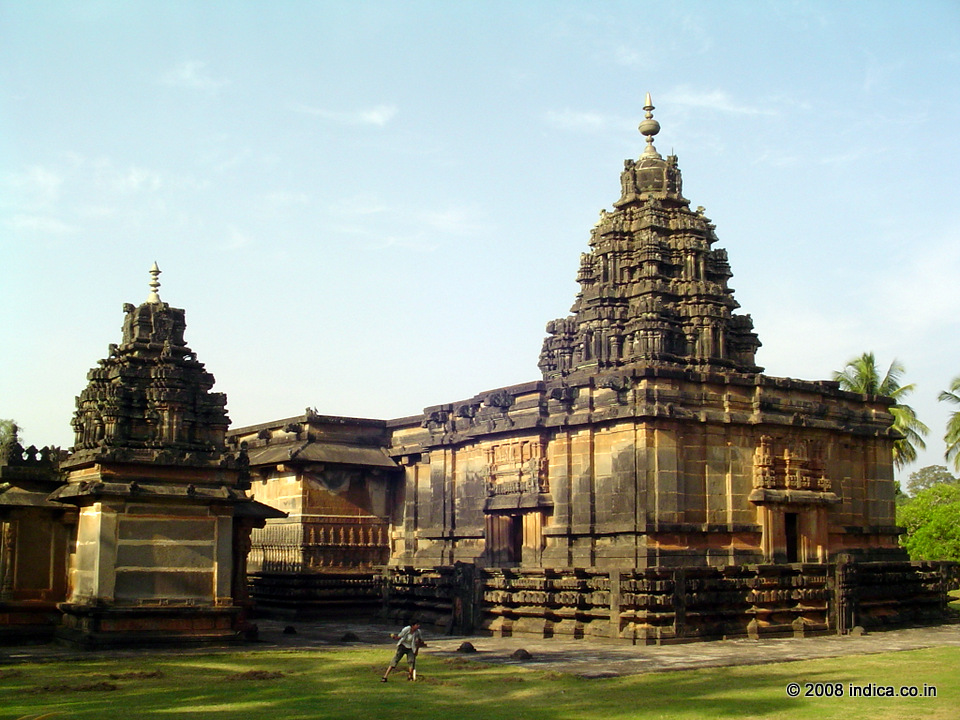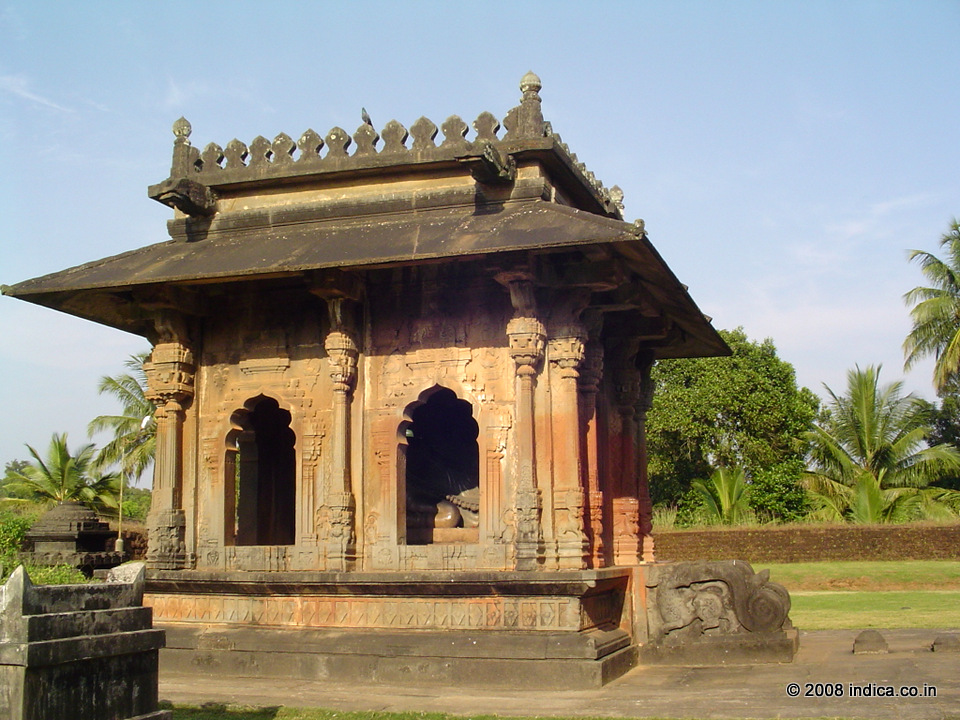Ikkeri
H
istory of Ikkeri is closely associated with the rise and fall of a ruling dynasty called the Nayakas of Keladi.Of their 250 years or so rule, Ikkeri was the capital for about 120 years. Their founding capital was Keladi ( thus the name Keladi Nayakas), a few kilometers from Sagar town. After Ikkeri the capital was moved to Nagara and then to Kavaledurga.
The Nayakas kingdom , encompassing the Malanad was as wide from the Arabian sea coast to the modern day Belur.
Ikkeri as their citadel was with three lines of fortification. The outer two were made of bamboo and timber. Nothing of that outer fortifications exist now. The remains of inner fortification is still to be seen in Ikkeri. The laterite built fort itself is in ruins. That's called the Ikkeri Fort or locally , Ikkeri Kote.
To really see the military architecture of Ikkeri Nayakas in its full glory, one has to visit Bakel, in Kerala. The fort there - again of hard laterite - is built on rocky terrain facing the Arabian sea. The style of constructions are astonishingly similar. Obviously Bakel once formed the western fringe of the Keladi Nayaka's kingdom.
The most beautiful structure of the Keladi Nayakas still surviving is the Aghoreshwara Temple in Ikkeri. That stands next to the innermost fortification; and probably within the second fortification around the capital.
It's interesting to contrast the accounts of two visitor to Ikkeri - Pietro dalla Valle and R K Narayan.
Pietro dalla Valle , the Italian adventure traveler who visited Ikkeri in 1623 left vivid description of the life and celebrations around the temple in Ikkeri. In all probability he was witnessing the Diwali calibrations in the capital. dalla Valle wrote,"........This Prince VENKTAPA NAIEKA was sometime Vassal andone of the ministers of the great King of VIDIA NAGAR ... but afterthe downfall of the king ... Venktapa Naieka ... remain'd absolute Prince of the State of which he was Governour, which also, being a good souldier, he hath much enlarged...........We saw going along the streets several companies of young girls, well clothed, after their manner, with some of the above mentioned wrought and figured silk from the girdle downwards; and from thence upward either naked, or else very pure linen, either of one colour, or striped and wrought with several, besides a scarf of the same work cast over the shoulder. Their heads were decked with yellow and white flowers formed into a high and large Diadem, with some sticking out like sun-beams, and others twisted together and hanging down in several fashions which made a pretty sight. All of them carry’d in each hand a little round painted stick, about a span long, or a little long which they stuck together after a musical measure, to the sounds of Drums are other instruments, and one of the skillfullest of the company sang one verse of a song, at the end of which they all reply’d seven or eight times in number of their meter with the word Cole, Cole, Cole, which signifies I know not what, but, I believe, ‘tis a word of joy …..I imagined it was for some extraordinary Festival. " *
Much later (though still very old for the current generations) R K Narayan has written about the ambient of this temple he experienced during a visit in the 1930s. In his travelogue made into a book titled "Mysore" R K Narayan writes,
"Chavuda Gowda later transferred his capital to Ikkeri (1560-1640). It was a flourishing capital. Its walls were sturdy and formed of three concentric enclosures; he built a palace of mud and timber, artistically gilded. Not much of this can be seen in Ikkeri now. All that remains of the old grandeur is the Aghoreswara temple. It is a very large, spacious, granite structure. It is empty and silent now, with grass growing in its corridors, and unmistakably conveying the impression of being fragment of a past, isolated, frozen, and left behind. The only living creature here seems to be the solitary priest who comes out of an obscure corner of the compound, with the keys of the temple, when some occasional visitor calls him up. If we could unwind the reels of time we might perhaps see, four hundred years ago, what an important position this temple must have occupied in the capital, how great the prestige of the priest of the king's temple, and in the evenings what a gathering must have assembled in the spacious pillared hall, with flowers and incense. " **
Aghoreshwara Temple in Ikkeri is located about 3 kilometers off as the main highway ( NH 206) crosses the small town called Sagar. The road that leads to Ikkeri starts right in the middle of this bustling town. Once you've find the way and wriggle out of the crowd , the ambient is very much typical Malanad. Narrow winding roads, paddy fields ,closely placed rows of slender tall arcanut trees , small lakes and sprinkled around it are the homes with terracotta tiled roofs.
On your left the Aghoreshwara Temple appears with vast open space all around the temple compound. The temple is located in a large rectangular compound, that is on a slightly higher ground. The compound wall made of hard coffee colored laterite , that is abundant in the Malanad region. There are two narrow access points to the otherwise large temple compound.
There is no fanfare whatsoever attached with popular temples or other tourists spots. The only exception probably is a makeshift fruit stall near the parking lot. Even there the shopkeeper feels like hiding behind the 'curtain' of pineapples that virtually makes the front wall of his shop.
As you enter the compound, what you feel is missing (rather pleasantly ) is a towering gateway to the temple compound. You expect a fitting gopuram for such a big temple. That's a tradition the Vijayanagara and to some extend the Hoysala artisans borrowed from the Tamil country's temple style. Instead the gateway to the temple compound a simple but majestic cubical arch carved out of granite across the narrow passage with a few steps.
Once you are inside , it is not very difficult to comprehend the plan of the temples and other structures inside. The very first thing is an elevated shrine of Nandi in the axis of the main temple. It is unusual to find such large Nandi image with a glasslike finish.
Right next to the Nandi shrine is a large Balipitha and a few smaller Balipithas. A Balipitha (the Altar Stone) is on which ritual offerings for the god ( usually cooked rice and flower) is performed. A few feet away in the open are a series of broken carved stones kept arranges. In fact that's the destroyed remains of the main deity's image. What remains here is merely the pedestal and a few pieces of the decorated arch that once stood around the Shiva's image.
It is difficult to say which is dominating; the temple is a pleasant blend of Vijayanagara and Hoysalastyle of architecture.
For those who are unaware of the nuances, here is a quick brief. Hoysalas were the dynasty that ruled most of the present-day Karnataka between 1026 and 1343 AD. Then came the rise of Vijayanagara Empire (1336 – 1646 AD) that at its peak ruled most of south India.
Arguably the Hoysala temples were the most intricatively carved temples ever built in india. Sculptures carved with jewel like precision and intricacy fills every inch - notably the outer wall - of a typical Hoysala temple. The whole temple plan, including the tower is built on starlike plan. Inside of the Hoysala temples spots many giant pillars, again is finely carved with intricate geometry. Popular examples of Hoysala style temple are the ones at Belur, Halebedu and Somnathpur.
On the other hand, Vijayanaga style is coarser with bold features. For example the giant composite pillars on the porch with rampant lion or Yali images carved on it. The temples in Hampi are the best examples of Vijayanagara style architecture.
The porch of the goddess's shrine in Aghoreshwara Temple is in the typical Vijayanagara style. Now take that spacious court that forms the bulk of the temple. In its size , it easily compares better with the Vijayanagara temples. The details and styles of the pillars resembles with Hoysala style. But it is made of hard granite , the favorite material of Vijayanagara artisans. So are the pilasters around the Nandi shrine. Where as the giant Nandi inside is carved with the patience and zeal one can feel from a Hoysala sculpture.
The tower over the temple's sanctum is executed in impeccable Hoysala style complete with that metallic pinnacle.
Ask the priests. They are friendly and more than happy to explain the background of the temple.
While the temple is built more that 500 years ago, political turmoil has put it through difficult phases. After that turmoil , according to the local traditions the temple is in active worship for the past 150 years. Aghoreswara temple stands right in the middle of the then capital of Keladi Nayakas. The remains of the fort and other artefacts speaks of the importance the temple commanded once.
At the peak of the kingdom , the sanctorum contained ornaments and decorations in gold weighing about 42 kilos. After the fall of Vijayanagara Empire , the region saw a series of raids and conquests by the Deccani Sultans. A raid by army one of the Deccani Sultans has done some serious damage to to temple.
Gone with one of those raids during the post Vijayanagara chaos was the gold; the idol, that was broken into pieces. Right now what remains of this idol is a pedestal of the idol and a few pieces of the arch that stood over it. Broken it is , the details still talks of the majesty of the carving.
You can see these few pieces kept in the courtyard right next to the Nandi shrine. The carving is executed in pitch black granite, as oppose to the pinkish granite used for the temple structure.
The feet of Shiva is seen at the center of the pedestal. Anything above angle is missing. The feet in fact is carved with a pair of Paduka ( wooden open Sandals). The toe grip and heels as interesting to note.
On either side of Shiva's feet are the two pairs of feet of female deities. All it seems are in standing posture.
Another piece is part of that ornate arch once stood above the trio. Much is left for ones imagination.
Now into the sanctorum. A large Shiva Linga is the main idol under worship. The sanctorum itself is a huge chamber with images of attendee deities standing on either side of its sanctorum. Along the wall of the main hall are images of Ganapati and Subrahmaniya. All are large detailed images installed into the giant alcove like shrines on either side as you approach the inner sanctorum.
Ikkeri is about 3 kilometers south of Sagar, a small town in Shimoga district. There is no train connection to Sagar, as the existing route is under going as gauge conversion work. So the only public transport mode for Sagar is the bus service - both KSRTC and private operated. The bus stand is located inside the town , right next to the NH 206. The are many bus servivces from various towns in Karnataka to Sagar. Bus serveces from Shimoga to Uttar Kannada va HN 206 pass along Sagar. For example buses to Jog falls are mostly via Sagar. So look for a direct bus to Sagar.
If that is not possible try a bus to Shimoga. There are many more buses to Shimoga from most of the large town in Karnataka. From shimoga , there are frequent bus services to Sagar. Distance from Shimoga to Sagar is about 75 km. Bus service should take about one and half hours from Shimoga to Sagar. Distance to Jog falls from Sagar is 30 km.
From Sagar town take a an auto-rickshaw to Ikkeri. Negotiate for a package. That is for the up and down trip with a waiting time of about 1 hour at Ikkeri. Remember, if you leave to auto-rickshaw at Ikkeri , its a bit difficult to get another one to back to Sagar.
You can extend the tour a little by adding the Ikkeri Fort and Varadamoola in the route. See the route map to Ikkeri shows at the top.
Source of quotes:
* -"A Forgotten Empire: Vijayanagar; A Contribution to the History of India" by Robert Sewell
-"A history of South India" by K A Nilakanda Sastri.
** "Mysore" by R K Narayan

Route map for Ikkeri and Varadamoola from Sagar
Route map for Ikkeri and Varadamoola from Sagar

Ikkeri Temple, the elephant balustrades at the porch.
Ikkeri Temple, the elephant balustrades at the porch.

Aghoreshwara Temple at Ikkeri
Aghoreshwara Temple at Ikkeri, Shimoga

The Aghoreshwara Temple in Ikkeri
The Aghoreshwara Temple in Ikkeri was built by the Keladi Nayakas , who were once feudatories to the Vijayanagara empire.

Nandi Shrine
Nandi shrine at The Aghoreshwara Temple in Ikkeri
Soapstone sculptures
The beauty of the Hoysala templs , particularly its intricate carvings owes a lot to one material - Soapstone. Unlike granite, sandstone and marble used in the construction of most of India's ancient monuments, soapstone is softer with some peculiar properties that set it apar from the former materials. To give you an idea , the softer version of the soapstone can be carved even with your finger nail.
